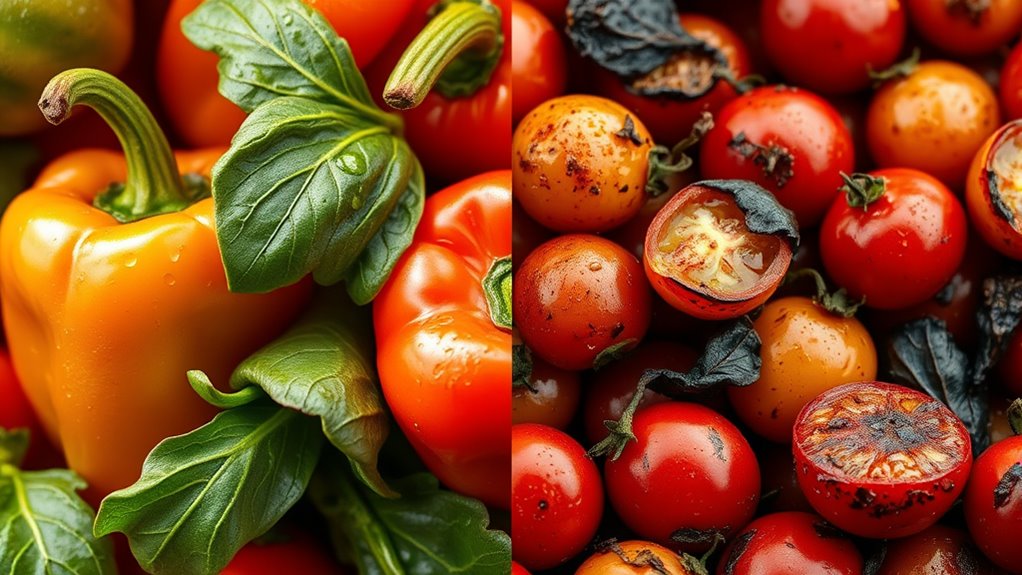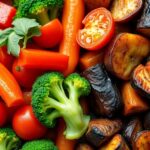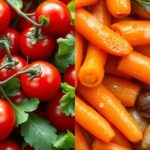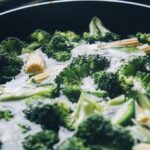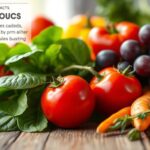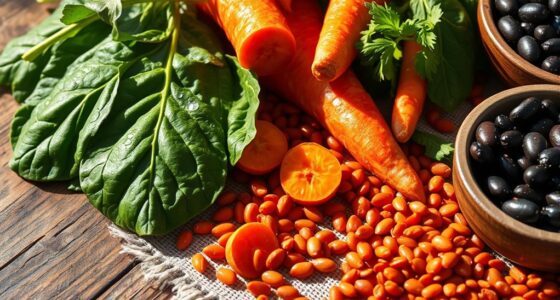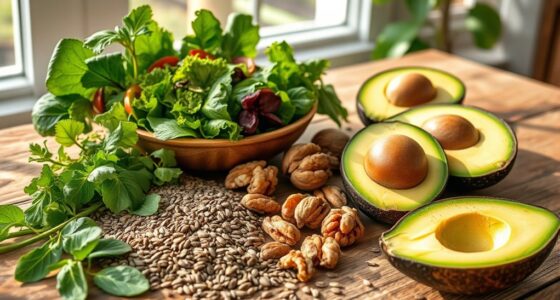When you eat raw foods, you mainly get their vitamins intact, especially water-soluble ones like vitamin C and B vitamins. Cooking can break down these vitamins but also makes some nutrients, like lycopene in tomatoes or beta-carotene in carrots, more accessible and easier for your body to absorb. The method and duration of cooking influence nutrient retention and enzyme activity. Keep exploring to discover how different techniques can maximize your nutrient intake and health benefits.
Key Takeaways
- Cooking can reduce water-soluble vitamins like vitamin C and B vitamins through leaching into cooking water.
- Heat from cooking enhances bioavailability of nutrients such as lycopene and beta-carotene.
- Steaming and microwaving preserve more nutrients than boiling, which causes vitamin loss.
- Raw foods retain higher levels of their original vitamins, but cooking can deactivate enzymes that aid digestion.
- Combining raw and cooked foods optimizes nutrient intake and absorption for overall health.

When you cook food, it can substantially change its nutrient content, affecting how much of certain vitamins and minerals your body absorbs. One key aspect of this process involves vitamin retention. Cooking can cause some vitamins, especially water-soluble ones like vitamin C and B vitamins, to break down or leach into cooking water. As a result, the nutrient levels in the food decrease, reducing their availability for your body. Conversely, certain nutrients become more accessible through cooking, such as lycopene in tomatoes or beta-carotene in carrots, which become more bioavailable when heated. This means that, depending on what you cook and how you cook it, the overall vitamin content can either diminish or improve.
Cooking can both reduce vitamin levels and enhance nutrient bioavailability, depending on the method used.
Enzyme activity also plays a essential role in how cooking impacts nutrients. Raw foods contain enzymes that assist in digestion and nutrient absorption. When you cook food at high temperatures, these enzymes are often destroyed, which can influence how your body processes the nutrients present. For example, raw vegetables contain active enzymes that help break down complex compounds, making nutrients more accessible. Once cooked, these enzymes deactivate, potentially slowing down digestion or changing how nutrients are absorbed. Although enzyme activity is lost during cooking, this isn’t necessarily negative, as heat can also help neutralize harmful bacteria and reduce certain anti-nutrients that block mineral absorption. enzyme activity can be preserved with gentle cooking methods, allowing some beneficial enzymes to remain active.
The balance between preserving nutrients and making others more bioavailable depends on your cooking methods. For instance, steaming or microwaving tends to retain more vitamins compared to boiling, which can cause water-soluble vitamins to escape into the cooking water. Additionally, shorter cooking times preserve enzyme activity better, ensuring that some beneficial enzymes remain intact. On the other hand, cooking methods like roasting or grilling can break down cell walls in vegetables, releasing nutrients and improving bioavailability even as some vitamins are lost.
Ultimately, understanding the impact of cooking on nutrient retention and enzyme activity helps you make smarter choices. If you’re aiming to maximize vitamin intake, quick steaming or eating raw whenever safe and practical can be beneficial. For nutrients that become more bioavailable through cooking, such as lycopene, cooking methods that gently heat food can enhance their absorption. By balancing raw and cooked foods based on these factors, you can optimize your nutrient intake and support your overall health.
Frequently Asked Questions
Do Cooking Methods Affect Nutrient Retention Differently?
Cooking methods do affect nutrient retention due to differences in nutrient stability and cooking variability. For example, boiling can cause water-soluble vitamins to leach out, reducing their content. Steaming preserves more nutrients, while frying may add fats that alter nutrient profiles. You should choose your cooking method carefully to maximize nutrient retention, considering how each technique impacts the stability of key nutrients and the variability it introduces.
Are Some Nutrients Only Available in Cooked Foods?
You might be surprised to learn that some nutrients become more available after cooking. For example, cooking tomatoes boosts lycopene bioavailability by breaking down cell walls and inactivating enzymes that degrade it. While certain nutrients are only available through cooked foods, cooking can enhance nutrient bioavailability by reducing enzyme activity that would otherwise break down essential compounds. So, cooking can release nutrients not accessible in raw form.
How Does Storage Impact Nutrient Levels in Raw Versus Cooked Foods?
Storage impacts nutrient levels in both raw and cooked foods through storage degradation and nutrient stability issues. When you store raw produce, nutrients like vitamin C can degrade quickly, especially with exposure to light and air. Cooked foods may lose nutrients over time due to moisture loss or heat exposure. To preserve nutrients, keep foods in airtight containers, refrigerate promptly, and consume them soon after purchase or cooking.
Can Eating Raw Foods Cause Foodborne Illnesses?
Eating raw foods can be a gamble with your health, like walking a tightrope without a safety net. You risk Salmonella and other foodborne illnesses, especially if proper hygiene isn’t maintained. Cross-contamination concerns increase when raw foods come into contact with other ingredients or surfaces. To stay safe, wash produce thoroughly, handle raw meats carefully, and consider cooking foods to eliminate harmful bacteria. Your health depends on your precautions.
Do Cooking Techniques Influence Flavor and Nutrient Preservation?
Cooking techniques definitely influence flavor enhancement and texture modification. For example, roasting brings out deep, caramelized flavors, while steaming preserves delicate tastes. Proper methods can make foods more appealing and easier to chew, enhancing your overall eating experience. However, some nutrients may degrade with certain techniques, so balancing flavor and texture with nutritional preservation is key. Experimenting with different methods helps you enjoy diverse flavors and textures while maintaining nutrient quality.
Conclusion
Understanding the nutrient differences between raw and cooked foods helps you make smarter choices. Remember, each method offers unique benefits, much like two sides of the same coin. Whether you prefer raw’s freshness or cooked’s enhanced flavors, knowing their impacts empowers you to nourish your body wisely. So, next time you decide how to prepare your meal, consider this: isn’t life itself a delicate balance of raw and cooked, of nature and nurture?
Ilana has been a vegan for over 10 years. She originally made the switch for health reasons, but soon found herself becoming more and more passionate about the ethical and environmental implications of a vegan lifestyle. Ilana is the author of The Graceful Kitchen, a blog all about veganism. She loves to cook up delicious and nutritious vegan meals, and share her recipes with others who are interested in leading a cruelty-free life. Ilana is also a strong advocate for using whole foods as the foundation of a healthy diet, and believes that going vegan is one of the best ways to achieve this.
